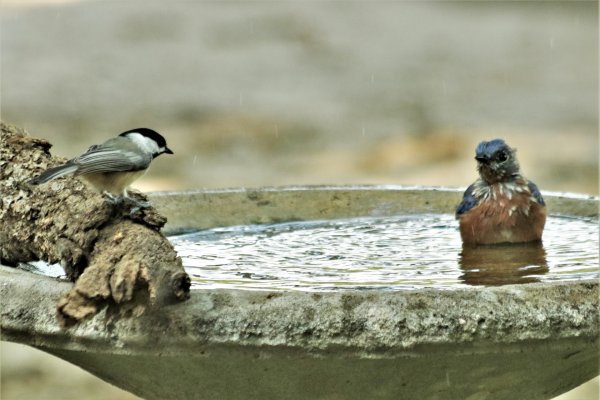- Home
- Baths
Bird Baths
Bird baths, and the water they contain, are one of the most under-appreciated ways to attract birds to your back yard. Most people think feeders are the answer for bringing birds in, and they are good. But bird baths can attract birds that would otherwise never come to a seed feeder. Read on for our tips to use bird baths and water for your back yard birds.
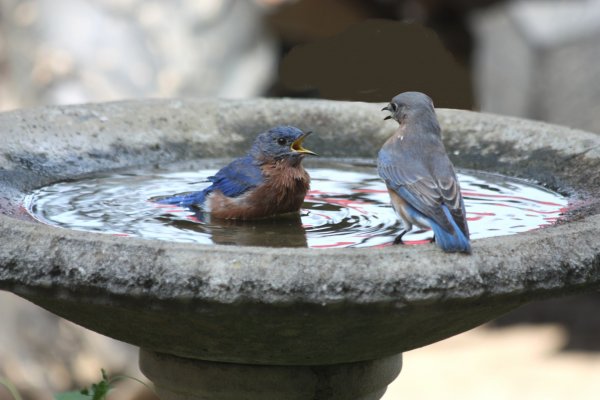
Types of Bird Baths
Bird baths come in four (4) main styles. All are useful, so don’t think one style is “the one” to use.
Pedestal
Pedestals are the baths that most people visualize when they think of bird baths. These are designed to elevate the water above the ground, by attaching a shallow tray to the top of a column, or pedestal. The advantage of this type is two-fold. By elevating the tray above ground, it makes it harder for a predator, like a cat, to sneak up on a bird taking a drink or bath. It also makes it easier for us to watch through a window. These have one disadvantage; if not anchored or well balanced, they can be knocked over and broken.
Pedestal baths come a mind-boggling array of shapes, sizes, colors, and materials. You’ll find them made out of plastic, or concrete, or metal, or ceramic. Some are utilitarian, while others are highly decorated. Some of them have the tray permanently attached to the column, while it is removable on others. The advantage of a removable tray is these are easier to clean. Just pop it off and hose it down.
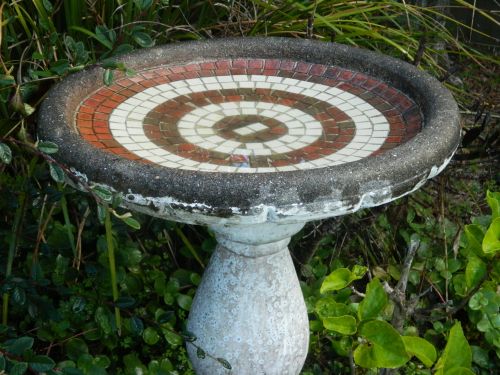
Hanging
A hanging bird bath is a shallow tray you hang from a tree limb or hook, typically with three short lengths of chain. It functions much as a pedestal bath, but with one small disadvantage. A strong wind can blow it around somewhat. The problem is this can cause water to spill out, or have the tray even fall off the hook if not properly secured.
On-the-Ground
This style is a shallow tray placed on the ground. It’s as simple as that. There are two issues you need to be careful of with this type of bird bath, though. Since it is not elevated, it can be harder to watch the birds using it. And it makes them a bit more likely to become prey to a cat. But, this style also has an advantage over the pedestal type. You can’t knock it over and break it.
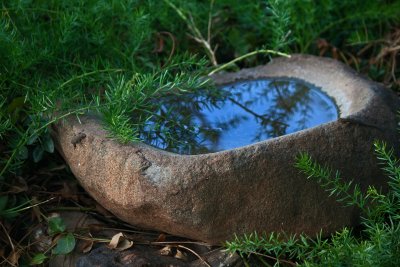
In-Ground
This is almost identical to the on-the-ground style, except the tray is set slightly into the ground. In my opinion, there is no real advantage to this style over the ones placed on the surface of the ground. Also, the same two issues with on-the-ground ones applies here as well. And it can’t be knocked over, as well.
Tips
Now that you have an idea of the options, here are some tips to help you get the most out of whichever style you prefer.
Location
Select the location in your yard before you buy the bath. This will help you decide which style of bath is most appropriate. Consider the vegetation around, and above, the location, as well as the sightline from your window. If there’s too much vegetation, you might have troubles watching the birds. And, if there is way too much vegetation around the bath, the birds might not come to it as much as they otherwise would. Take a look at the image below. This is a gorgeous setting for a bird bath. But, if you look closely, its obvious birds could come to this bath and be shielded from view by the vegetation.
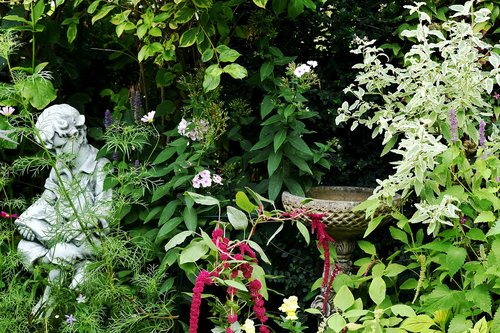
Water Level
Birds that will come to your yard are most likely not going to be water birds. So, don’t fill the bath too deep, or you run the risk of excluding some of the songbirds in your yard. The maximum depth should be no more than 2 inches for a flat tray. If you have a tray that is not flat, but slightly conical, it is okay to exceed the maximum of 2 inches. The reason is that the water depth will increase gradually as you move from the edge to the center, and the birds can use whatever depth they feel comfortable with. A larger bird might walk out into the deeper water, while a smaller songbird will stay closer to the edge where the water is shallower.
Surface to Walk On
Many of the materials used for bird baths can be somewhat slick. This increases the chance a bird will slip as it lands, normally causing it to immediately fly away. One way to reduce that chance is to provide some pebbles or small stones in the water for the birds to step out onto. Often, these are placed around the edges of the water. This will help their confidence, and make the bath look more natural. The one downside to adding stones is they make it harder to clean the bath. Not that you have to clean each stone, but you will need to remove the stones before cleaning, then replace them after the cleaning, adding a bit more time to the effort. In my mind, if those extra steps make you less likely to clean the bath, then you might be best off to omit them and keep the bath clean.
Accessories
Water Heaters
Water heaters can be quite useful during winter in more northern areas. When the temperature is below freezing, it can be difficult to find open water for some birds, so a bird bath with a water heater can be a lifesaver, quite literally.
Fountains and Drips
Solar powered fountains in summer are a really good way to attract birds to your bath. The sight and sound of the moving water will get their attention. You can also buy an attachment for your bird bath that allows for a slow drip of water from above the bath down into the water. These can be very effective at attracting birds as well.
Cleaning
As with feeders, it is wise to keep bird baths cleaned. Invariably, birds will poop into the water in the bath. And since bird droppings can carry disease, you wouldn’t want birds drinking or bathing in that water. The result can be more sick birds. So, keep it clean.
But how? And how often to clean? Some people recommend using a mild bleach to kill any pathogens, then a complete rinse before refilling. Others suggest a stiff brush with high water pressure through a hose. It’s best to clean a bird bath once a week. Sometimes we don’t have the time to scrub one of our baths (we have three in our backyard), so we hose it down with high pressure, but do so every day or two to keep any mess from building up.
Water Gardens
One other approach to providing water to your birds in the backyard is with a water garden. These can be like small pools or ponds, with a fountain or waterfall, wetland-type plants, and maybe goldfish or koi. These can be wonderful additions to your backyard; they are beautiful and can really help attract birds. However, sometimes you get more than you bargain for. There are numerous accounts of herons or egrets finding a water garden and eating all the goldfish or koi. One other thing to consider with a water garden is mosquitoes. The standing water will give mosquitoes a place to lay their eggs. Without fish to eat the larvae, or some type of insecticide to kill them, you can have a problem on your hands.
Other Wildlife
Bird baths benefit more than just birds. Other wildlife species will appreciate the availability of water, particularly in more arid areas, such as deer and squirrels. Dogs and cats will also take advantage of the water.
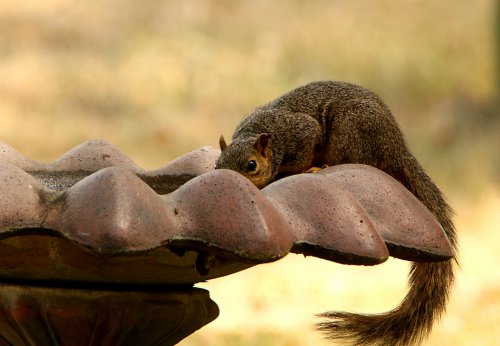 |
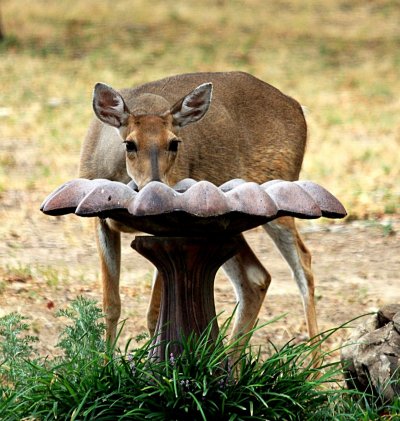 |
Summary of Bird Baths
So, there you have our tips on providing water for birds in your backyard. Please get it a try. You can attract birds that wouldn’t otherwise come to a feeder, and that’s always fun. And the care they require is really not much compared to the benefits. So, do it. And enjoy!
